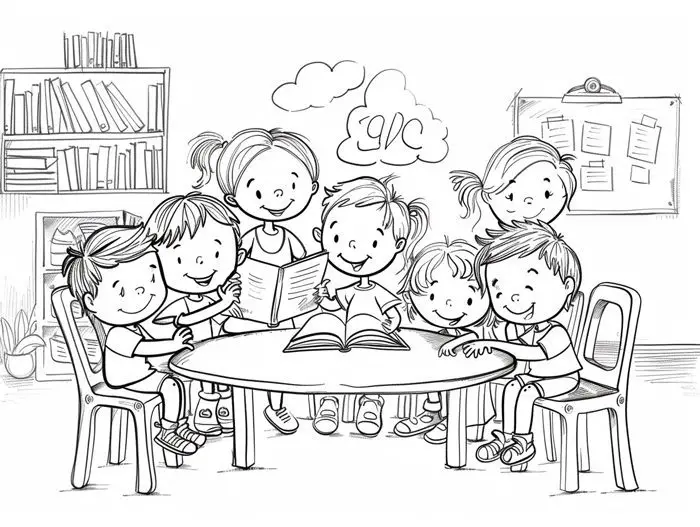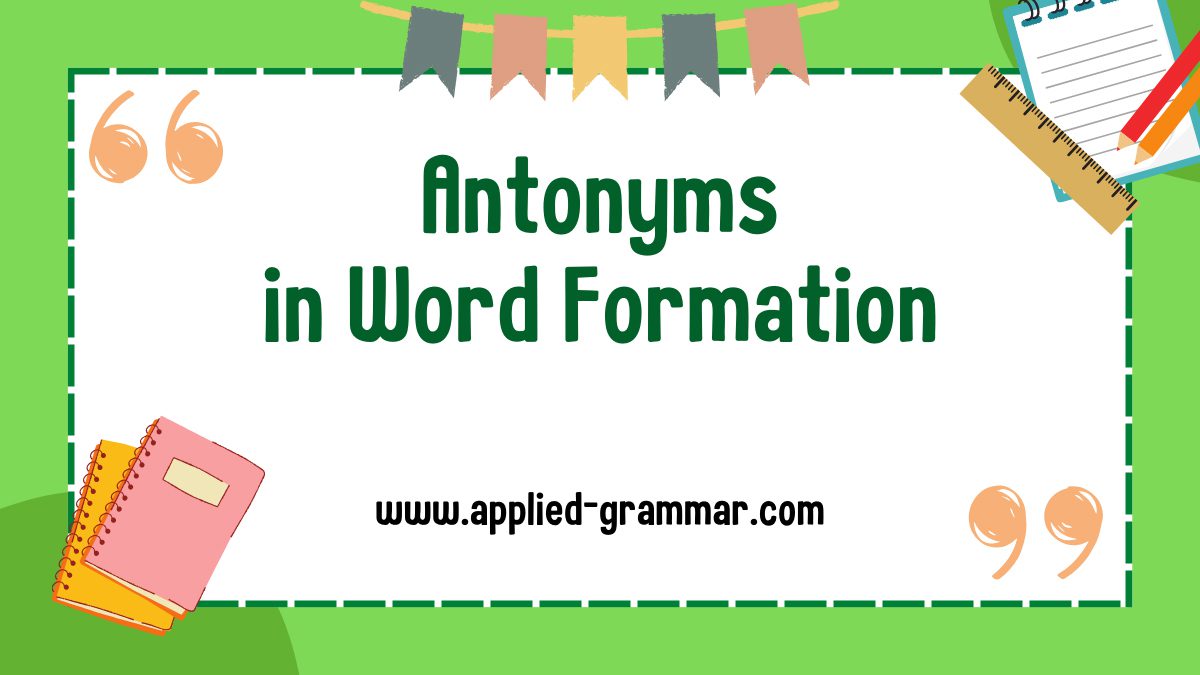Are you interested in expanding your vocabulary and improving your word formation skills? If so, you’ve come to the right place. In this text, we’ll explore the intriguing area of antonyms in word formation, specifically focusing on prefixes and suffixes for creating antonyms.
Antonyms, as you may already know, are words that have opposite meanings. They add depth and nuance to our language, allowing us to express contrasting ideas and concepts. By understanding how prefixes and suffixes can be used to create antonyms, you’ll be able to enhance your communication skills and become a more effective writer and speaker.
Throughout this article, we’ll investigate into the various ways in which prefixes and suffixes can be combined with base words to create antonyms. We’ll explore common examples and patterns, providing you with a solid foundation for expanding your vocabulary. So, let’s immerse and discover the power of word formation through prefixes and suffixes for creating antonyms.
Key Takeaways
- Antonyms are words that have opposite meanings and can be classified into gradable, complementary, and relational antonyms.
- Understanding prefixes and suffixes is essential for word formation and can significantly impact the meaning of a word.
- Common prefixes used to create antonyms include un-, mis-, dis-, in-, ir-, and il-.
- By adding a prefix to a word, you can change its meaning and create its antonym (e.g., happy – unhappy).
- Suffixes such as -less, -ful, -un, and -in can also be used to create antonyms.
- By mastering the use of prefixes and suffixes, you can become a more effective writer and speaker and expand your vocabulary.
What are Antonyms?
Antonyms are words that have opposite meanings. They are an essential part of language and play a vital role in communication. By understanding the use of prefixes and suffixes in word formation, you can expand your vocabulary and enhance your communication skills.

Definition of Antonyms
Antonyms can be classified into three main types: gradable antonyms, complementary antonyms, and relational antonyms.
- Gradable Antonyms: These antonyms represent opposite ends of a spectrum or scale. They express degrees of a quality or attribute. For example: big and small, loud and quiet, happy and sad. Gradable antonyms allow for comparisons and the possibility of intermediate states. By modifying the noun or verb with intensifiers like very, extremely, or slightly, you can convey varying degrees of the quality being described. Gradable antonyms add nuance and precision to our language, enabling us to express subtle differences in intensity or magnitude.
- Complementary Antonyms: These antonyms represent an either/or relationship, where the presence of one word implies the absence of the other. They are complete opposites that represent two contrasting states or conditions. For example: light and dark, young and old, full and empty. Complementary antonyms emphasize the presence or absence of a specific quality or condition. Using them in a sentence can succinctly convey opposing concepts. For instance, saying “The room is dark” signifies the absence of light. Complementary antonyms help effective communication by emphasizing the presence or absence of a particular quality.
- Relational Antonyms: These antonyms have an opposite relationship based on their connection or comparison to each other. They rely on the context of their relationship rather than simply opposite meanings. Relational antonyms help us understand the contrasting nature of things. Examples include buy and sell, teacher and student, parent and child. Understanding the relational antonyms can provide insights into the connections and comparisons between different concepts.
- Prefix denoting “brain”: Encephalography, Encephalitis
- Prefix denoting “in, within, or inner”: Endocardium, Endoscopy, Endometrium
- Prefix denoting “intestine”: Enteropathy, Enterospasm, Enterococcus
- Prefix denoting “into, inward, or within”: Esotropia, Esophagus
- Prefix denoting “feeling or sensation”: Anesthesia, Hyperesthesia, Paresthesia
- Prefix denoting “female”: Estrogen
- Prefix denoting “porous or sieve”: Ethmos
Word Formation
In the English language, prefixes and suffixes play a vital role in word formation and can significantly impact the meaning of a word. By understanding the use of prefixes and suffixes, you can enhance your communication skills and become a more effective writer and speaker.

Prefixes
Prefixes are word elements that are added to the beginning of a word to change its meaning. They can denote negation, direction, quantity, or other specific qualities. Let’s explore some common prefixes and their meanings:
- “Un-” means not or opposite of, such as “unhappy” meaning not happy.
- “In-” and “non-” also indicate negation or opposite, as in “incorrect” and “nonexistent.”
- “Mis-” and “ir-” can both imply wrong or incorrectly, like “misbehave” and “irregular.”
It’s important to note that double letters are possible when adding prefixes to certain words. For example, when you add the prefix “im-” to words starting with “m,” you get two “m’s” as in “immeasurable.” The same applies when adding “un-” to words starting with “n,” like “unnoticeable.” This repetition of letters can occur with other prefixes as well.
When adding a prefix to a word, the spelling of the base word remains unchanged. For example, the prefix “un-” does not alter the spelling of the word “happy.” Similarly, the prefix “re-” would not change the spelling of the word “live,” as in “relive.”
Be cautious of lookalike words that may appear to contain prefixes but do not. For instance, the “un” in the word “uncle” is not a prefix, just as the “re” in “reach” or “real” is not a prefix.
Suffixes
Suffixes, on the other hand, are word elements added to the end of a word to modify its meaning or grammatical function. They can indicate things like verb tense, noun pluralization, or adjective comparison. Let’s investigate into some essential information about suffixes:
- The suffix “-er” can denote a person who performs an action, like a “teacher,” but it can also be added to adjectives and adverbs to compare two things, as in “faster” and “stronger.”
- When adding a suffix to a base word, the spelling of the word may change. This is particularly true for words ending in the letter “y.” For example, when we add the suffix “-ness” to the word “crazy,” we replace the “y” with an “i” to create “craziness.” Similar changes can be observed with other suffixes, depending on the base word.
- Keep in mind that some suffixes have multiple meanings and can modify the word in various ways. A careful understanding of the context is necessary to determine the exact function of the suffix.
Creating Antonyms with Prefixes
One of the effective ways to create antonyms is by using prefixes. By adding a prefix to a word, you can change its meaning to the opposite. This technique not only enhances your communication skills but also makes you a more effective writer and speaker. Let’s explore some common prefixes used for creating antonyms and see examples of how they work.

List of Common Prefixes for Creating Antonyms
Here are some prefixes commonly used to create antonyms:
- Un-: This prefix is widely used and adds the opposite meaning to a word. For example, adding “un-” to “happy” creates the antonym “unhappy.”
- Mis-: This prefix denotes doing something wrongly. For instance, “misinforming” means providing incorrect information.
- Dis-: Similar to “un-,” this prefix also conveys the opposite meaning. For example, “dislike” is the antonym of “like.”
- In-: This prefix is used to create antonyms that imply the absence or opposite state of something. For instance, “invisible” means not visible.
- Ir- and Il-: These prefixes are used instead of “un-” with certain words to create antonyms. For example, “regular” becomes “irregular” and “possible” becomes “impossible.”
Examples of Antonym Creation with Prefixes
Let’s explore some examples of creating antonyms using prefixes:
- Prefix: Un-, Word: Happy, Antonym: Unhappy
- Prefix: Mis-, Word: Lead, Antonym: Mislead
- Prefix: Dis-, Word: Like, Antonym: Dislike
- Prefix: In-, Word: Visible, Antonym: Invisible
- Prefix: Ir-, Word: Regular, Antonym: Irregular
- Prefix: In-, Word: Possible, Antonym: Impossible
As you can see, by adding a prefix, you can completely change the meaning of a word and create its antonym. This technique allows for more precise and nuanced expression in your speaking and writing.
Understanding the use of prefixes in word formation is a valuable skill in communication. It enables you to convey your thoughts with greater accuracy and create effective antonyms. Practice using prefixes to create antonyms, and you’ll notice a significant improvement in your language skills.
Remember, mastering the art of antonym creation with prefixes requires practice and attention to context. By understanding the meanings and patterns of prefixes, you can become a more proficient communicator. So, keep exploring the world of prefixes and elevate your language skills to new heights.
Creating Antonyms with Suffixes
Plus to prefixes, suffixes can also be used to create antonyms, or words with opposite meanings. By simply adding a suffix to a word, you can completely change its meaning. Understanding common suffixes and how they work can greatly enhance your language skills and make you a more effective communicator. Let’s explore some common suffixes used for creating antonyms and see examples of how they can be used.

List of Common Suffixes for Creating Antonyms
- -less: This suffix is used to create antonyms that indicate the absence or lack of something. For example:
- Hopeless – without hope
- Fearless – without fear
- Limitless – without limits
- -ful: This suffix is used to create antonyms that indicate a fullness or abundance of something. For example:
- Hopeful – full of hope
- Joyful – full of joy
- Colorful – full of color
- -un: This prefix is used to create antonyms that indicate the opposite or reversal of something. For example:
- Happy vs. Unhappy
- Tied vs. Untied
- Covered vs. Uncovered
- -in: This prefix is used to create antonyms that indicate a negation or opposite of something. For example:
- Ept vs. Inept
- Active vs. Inactive
- Valid vs. Invalid
- Happy vs. Unhappy: By adding the suffix -un to the word happy, we create the antonym unhappy, which means not happy or sad.
- Kind vs. Unkind: By adding the prefix un- to the word kind, we create the antonym unkind, which means not kind or mean.
- Qualified vs. Unqualified: By adding the prefix un- to the word qualified, we create the antonym unqualified, which means not qualified or lacking the necessary skills or knowledge.
By understanding the meanings and patterns of these common suffixes, you can easily create antonyms and expand your vocabulary. Practice using these suffixes in your writing and speech to become a more proficient communicator.
Remember, the power of language lies in your ability to manipulate words and their meanings. By mastering the use of prefixes and suffixes, you can elevate your language skills and effectively convey your thoughts and ideas. So keep exploring and experimenting with these linguistic tools to become a more confident and versatile communicator.
Conclusion
By understanding the power of prefixes and suffixes in creating antonyms, you can enhance your communication skills and become a more effective writer and speaker. This article has provided you with a list of common prefixes and suffixes that can be used to change the meaning of a word to its opposite.
Remember, mastering the meanings and patterns of these word formation elements is crucial to becoming a proficient communicator. By practicing and exploring the various combinations of prefixes and suffixes, you can elevate your language skills and express yourself with greater precision and nuance.
So, whether you’re looking to expand your vocabulary, improve your writing, or simply become a more confident communicator, don’t underestimate the power of prefixes and suffixes. Embrace their ability to transform words and unlock a world of possibilities in your language usage.
Continue to explore and experiment with prefixes and suffixes, and watch as your language skills flourish. With practice, you’ll soon find yourself effortlessly incorporating antonyms into your everyday conversations and written work. So go ahead, jump into the world of word formation, and let your language skills soar.
